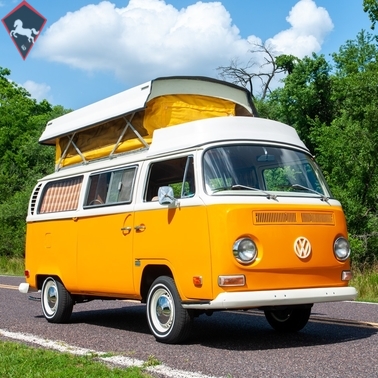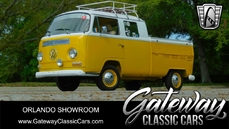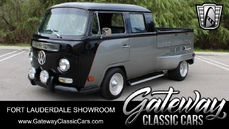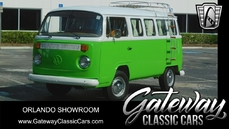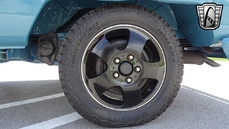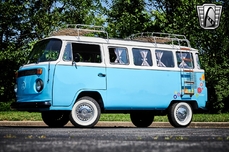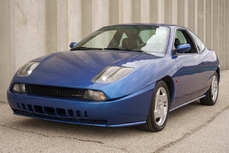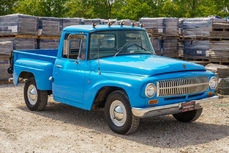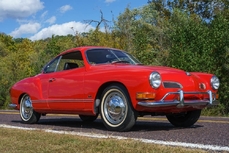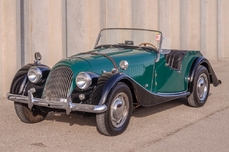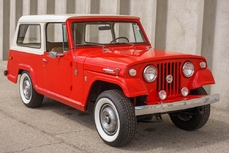Volkswagen Typ 2 (post 1967) Bulli 1.9L four-cylinder 1971
Allgemeine Beschreibung :
1971 Volkswagen Westfalia Camper
Fresh restoration inside and out!
Originally from Oregon and California and it really shows
New white over Sierra Yellow (code L11H) exterior with tan and black interior
Rebuilt 1.6L four-cylinder engine bored out to 1.9L
Fewer than 1,000 miles on rebuilt engine
Four-speed manual transmission
New – canvas top, window and body seals, interior, refrigerator
Penthouse upper sleeping cot, front child cot and sofa bed
MotoeXotica Classic Cars has the perfect vehicle for those summer camping trips, a 1971 Volkswagen Westfalia Camper. Often called Westies, these vans with built-in campers still retain a huge following and have been one of the hottest classic cars of 2018! This one is a harder to find early type 2 bus that has the penthouse pop top! Plus it is finished in our personal favorite Sierra Yellow exterior which makes this one hot bus!
This particular example is originally from the Pacific Coast, Oregon and California, specifically, it benefitted from a fresh restoration. Dressed in new White over Sierra Yellow, (code L11H), with new clearcoat on top, the van’s paint and trim are in overall excellent order.
The glass panels on this late bay are in overall great condition, intact with no major cracks, chips or haze. The van’s lights are in excellent order while the van’s bodywork is solid and straight. The white bumpers fit tightly to the body, the engine bay is very tidy and the cargo bay is in great shape. This Westie has a new canvas top plus new window and body seals.
The van rolls on a fresh set of Hankook Optimo whitewall tires, size 185/75R14 at all four corners. The tires have lots of tread while the factory, vented steel wheel covers are in overall very good order.
Out back, there is a rebuilt 1.6L four-cylinder engine that has been bored out to 1.9L and has fewer than 1,000 miles on it since the rebuild. This motor really pulls strong and the extra power and torque is always very welcoming on a VW bus! The motor is mated to a four-speed manual transmission that shifts great!
Inside, the van’s tan front bucket seats are in excellent condition while the seats in the middle are in very good order while the contrasting black carpeting is in very good order. There’s enough space in the middle section to seat four adults or five children, where they will enjoy the new refrigerator. Other Westfalia features include a “penthouse” upper sleeping cot, a front child cot and a sofa bed. The headliner is in better-than-average order while the black, factory two-spoke steering wheel is in satisfactory condition. The black instrument panel is also in decent shape, while the inner door liners are in very good condition. This is a radio delete model and the wipers and horn are inoperable.
When Volkswagen transitioned to the bay-window or bread loaf model with large, single curved windshield and sliding side door, the Westfalia camper was modified to include an angled pop-top. This design provided space for a large child’s cot overhead and on later models, the pop-top was further enlarged to fit a full bed large enough for two adults.
The add-on side tent underwent a complete redesign. The new model (referred to in publicity materials as an Add-a-Room tent or a Motent) superficially resembles the late Split-windshield’s framed tent in general shape and colors but is otherwise quite different. For one, the tent’s frame is now external, with the canvas supported by elastic loops and plastic hooks, somewhat like a shower curtain. Instead of a single opening front panel, there is a zippered screen door in the middle of the front (side away from the bus) with a small awning flap that can be lowered for wind and rain protection. This tent also features a waterproof floor and the attachment method on the vehicle side results in a securely closable shelter (i.e., no more gap below the bus floor).
Standard Westfalia equipment included:
Various foldout seat arrangements for sleeping
Birch plywood interior panels
Laminated plywood cabinetry for storage
Ice box or cold-box
Sink (some models)
Water storage and pump
Electrical hookups
Curtains
Screened jalousie (Venetian blind) windows
Laminated folding table
Competition to this Volkswagen in 1971 included Chevrolet’s G-Series Van, Dodge’s B-Series Van, Ford’s Econoline Van and GMC’s VanDura.
If you desire a novel way to enjoy the Great Outdoors, if you’re a Volkswagen or van collector or if you happen to like German vehicles, stop by MotoeXotica Classic Cars today to look this VW Bus over.
VIN: 23122025441
This van is currently located at our facility in St. Louis, Missouri. Current mileage on the odometer shows 91,901 miles. It is sold as is, where is, on a clean and clear, mileage exempt title. GET OUT AND DRIVE!!!
CLICK HERE TO VIEW OUR YOUTUBE VIDEO!!!!!
Or Copy & Paste the Link Below to Watch Video:
youtu.be/0yk_EnSatxU
https://www.motoexotica.com/inventory/listing/1971-volkswagen-westfalia-camper/
1971 Volkswagen Typ 2 (post 1967) Bulli 1.9L four-cylinder is listed verkauft on ClassicDigest in Fenton (St. Louis) by for $42500.
Fakten der Auto
Karosserietyp : Auto Marke : Volkswagen Modell : Typ 2 (post 1967) Bulli Ausführung : 1.9L four-cylinder Hubraum : 1.9 Modelljahr : 1971 Karosstyp : Lieferwagen Lage : Fenton (St. Louis)
Verkauft
Angaben Zum Verkäufer
Verkauft
People who viewed this Volkswagen Typ 2 (post 1967) Bulli also viewed similar Volkswagen listed at ClassicDigest
Other cars listed for sale by this dealer
über Volkswagen
Die Volkswagen-Geschichte ist in der Tat eine faszinierende Geschichte von Innovation, Belastbarkeit und Wiederbelebung nach dem Krieg, die von verschiedenen Modellen gekennzeichnet ist, die in der Automobilgeschichte zu Ikone geworden sind.Das Volksauto (Volkswagen): Zunächst von Adolf Hitler in den 1930er Jahren als "Volksauto" oder "Volkswagen" auf Deutsch vorgestellt, war die Idee, ein erschwingliches und praktisches Fahrzeug für das deutsche Volk zu schaffen. Dieses Konzept führte zur Entwicklung des von Ferdinand Porsche entworfenen Volkswagenkäfers (oder des Typ 1).
Nachkriegsherausforderungen: Nach dem Zweiten Weltkrieg stand Volkswagen erhebliche Herausforderungen. Die Fabrik war stark beschädigt, und die Verbindung der Marke mit dem NS -Regime führte in einigen Regionen zu einem mangelnden Interesse an dem Auto.
Britische Intervention - Die britische Armee & Ivan Hirst: Die britische Armee übernahm die Kontrolle über die Fabrik in der unmittelbaren Nachkriegszeit. Major Ivan Hirst, ein Offizier der britischen Armee, spielte eine entscheidende Rolle bei der Wiederbelebung von Volkswagen. Er erkannte das Potenzial des Käfers und setzte sich für seine Produktion ein. Er überzeugte das britische Militär, mehrere tausend Autos zu bestellen. Diese Entscheidung hat dazu beigetragen, die Wiederbelebung der Marke zu starten.
Exporterfolg und der globale Anziehungskraft des Käfers: Der Käfer gewann nicht nur in Deutschland, sondern auch weltweit an Popularität und wurde zu einer Ikone des erschwinglichen Fahrwerks. Das einfache, zuverlässige Design und das einzigartige Erscheinungsbild machten es zu einem Favoriten unter den Verbrauchern weltweit.
Modellentwicklung: Im Laufe der Jahre führte Volkswagen verschiedene Modelle neben dem Käfer ein, wobei jeder zum Wachstum der Marke beitrug:
Typ 2 (VW -Bus oder Transporter): In den 1950er Jahren wurde er in den 1960er Jahren zu einem ikonischen Symbol der Hippie -Bewegung eingeführt und wurde wegen seiner Geräumigkeit und Vielseitigkeit geliebt.
Golf (Kaninchen in den USA): Der Golf (oder Kaninchen in den USA) wurde Mitte der 1970er Jahre ins Leben gerufen und markierte eine Verlagerung in Richtung Frontantrieb, modernes Design und Schrägheckpraktikabilität und wurde zu einem Eckpfeiler des Erfolgs der Marke.
Passat, Jetta und andere Modelle: Volkswagen erweiterte seine Aufstellung mit Modellen wie dem Passat und Jetta, die sich für verschiedene Marktsegmente befassen.
Herausforderungen und Innovationen: Trotz des Erfolgs stand Volkswagen vor Herausforderungen, einschließlich Qualitätsproblemen in den 1970er Jahren. Die Marke hat jedoch weiterhin neue Modelle und Technologien entwickelt und entwickelt.
Aufstieg des GTI und globaler Expansion: In den 1980er Jahren stieg der legendäre Golf GTI auf, eine Hochleistungsversion, die den Trend der heißen Luke auslöste. Volkswagen erweiterte auch seine globale Präsenz in diesem Zeitraum.
Die britische Intervention bei der Wiederbelebung von Volkswagen nach dem Zweiten Weltkrieg spielte eine entscheidende Rolle bei der Wiederbelebung der Marke. Während es in den 1950er und 1960er Jahren aufgrund des Erfolgs von Volkswagen in den 1950er und 1960er Jahren möglicherweise einige Spannungen oder einen Wettbewerb zwischen Automobilunternehmen gegeben hat, hat die Fähigkeit der Marke, innovative und beliebte Modelle zu produzieren, ihren Platz in der Automobilgeschichte festigend.
